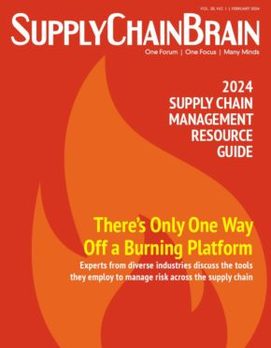
Home » Food Shortage? Supply Chain Optimization Reduces Impact on U.S. Stores
Food Shortage? Supply Chain Optimization Reduces Impact on U.S. Stores

September 24, 2008
When Sam's Club and Costco rationed the amount of rice individuals could purchase at their stores this spring in response to a global shortage of the grain, the move signaled to many commentators and consumers that the food shortage affecting much of the developing world could be coming to U.S. shores.
Thanks to widespread investment in advanced supply chain technology by American supermarket chains, consumers have no reason to fear widespread shortages any time soon--even of rice. What drove Sam's Club and Costco's actions? Both have experienced sharp increases in demand for rice in response to concerns about global food shortages, according to company officials. There is little reason to fear a rice shortage here, however the U.S. produces 88% of the rice consumed domestically. And, according to David Coia, a spokesman for the USA Rice Federation, the country is not experiencing a rice shortage. In fact, the U.S. typically exports 50% of its rice production--and increased exports 26% this year.
The supplies of other products are scarcer, however. Less soy and wheat went into the food supply this year than usual, largely due to increased planting of corn for ethanol production. As a result, products based on these key ingredients and their derivatives have higher prices and, in many cases, more limited production.
"When food supplies are tight," says Jeff Mitchell, Manhattan Associates' executive vice president, "companies focus first on reducing waste. Well integrated transportation, warehouse and forecasting solutions keep perishables flowing where and when they are needed, so stores get fresh product quicker and end up throwing out much less."
Supply chain solutions that allow companies to optimize inventory also ensure freshness while minimizing costs. Typically grocers' distribution centers hold onto fresh merchandise such as meat, produce or dairy products for 20-30 days. By the time the products arrive at the store, they may have only 10 days of shelf life left before they need to be discounted or discarded. By integrating their supply chain, leading grocers such as Wal-Mart and Kroger have drastically reduced the time that perishables sit in the warehouse and consequently reduced both their storage costs and spoilage rates--critical improvements as costs rise and product availability falls.
As a result of investments in the supply chain solutions that create these efficiencies, leading supermarkets in the U.S. have minimized out-of-stocks and increased revenues despite reduced product availability. The average grocer experiences a 7% out-of-stock rate. Supermarkets using integrated transportation and distribution management solutions typically have a 4% out-of-stock rate. For a mid-sized grocery chain, each 1% drop in out-of-stocks can translate into $300,000 in increased revenue annually--with no associated increase in costs. A 3% reduction in stock-outs, then, can mean nearly $1 million per year in increased revenues. With revenue increases on that order, it is easy to see why Gartner projects that spending on supply chain solutions that include transportation management components will increase to $800 million in 2011 from around $500 million last year.
Where the rationing at Costco and Sam's Club created a sense that the U.S. might be facing food shortages, full shelves at local grocers reassure customers that food supplies are stable and plentiful, reducing the likelihood of localized hoarding. As a result, supermarkets that manage their inventory well to reduce out-of-stocks have the further advantage of appearing more stable in a time of scarcity.
When prices rise, grocers can minimize costs by holding less inventory in the warehouse, creating quicker turnover on their shelves. In the past year, the price of core grocery items has risen faster than at any point in the last three decades: eggs are up 40%, cheese is 50% more costly, and flour has risen 65%. John Powell of the UN World Food Program expects that the increase in prices is likely to persist as a structural change and other experts predict food inflation to continue for four to 10 years.
With real-time point-of-sale information feeding automatically into inventory systems and ordering programs, grocers can dramatically reduce the time involved in forecasting and buying--and the amount they need to have on hand. One leading grocer cut the time required by its forecasting and buying process from 14 days to 14 hours by implementing an integrated inventory solution from Manhattan Associates that provided specific information on what products need to be replenished directly from the register to the distribution center to the order management system. As a result, the company's inventory level also dropped significantly, as less safety stock was required to cover the lag time between order and receipt of goods.
With rising costs of many common grocery items, supermarkets are looking for every opportunity to reduce costs. Even companies that have tightly managed their supply chains previously are finding new ways to further integrate their processes from planning through execution to reduce waste. For many, the first line of cost control comes from streamlining routing of deliveries, reducing the number of shipments and other purely transportation-related improvements.
Others have integrated distribution and transportation for significant benefits. The leading supermarkets, though, increasingly seek to unify their systems from forecasting through delivery in ways that allow real-time information--and inventory--to flow quickly through the entire supply chain. As a result, they are achieving continued reductions in cost, even in an environment of rising prices, and keeping goods on the shelves despite reduced supplies of key products.
In the end, it's those successes that keep both investors and customers happy--and a food crisis at bay in the U.S.
About the author: Eddie Capel is executive vice president, product management and global customer support for Manhattan Associates.
http://www.manh.com
RELATED CONTENT
RELATED VIDEOS
Subscribe to our Daily Newsletter!
Timely, incisive articles delivered directly to your inbox.
Popular Stories

2024 Supply Chain Management Resource Guide: There's Only One Way Off a Burning Platform
VIEW THE LATEST ISSUECase Studies
-
Recycled Tagging Fasteners: Small Changes Make a Big Impact
-

Enhancing High-Value Electronics Shipment Security with Tive's Real-Time Tracking
-

Moving Robots Site-to-Site
-
JLL Finds Perfect Warehouse Location, Leading to $15M Grant for Startup
-
Robots Speed Fulfillment to Help Apparel Company Scale for Growth



